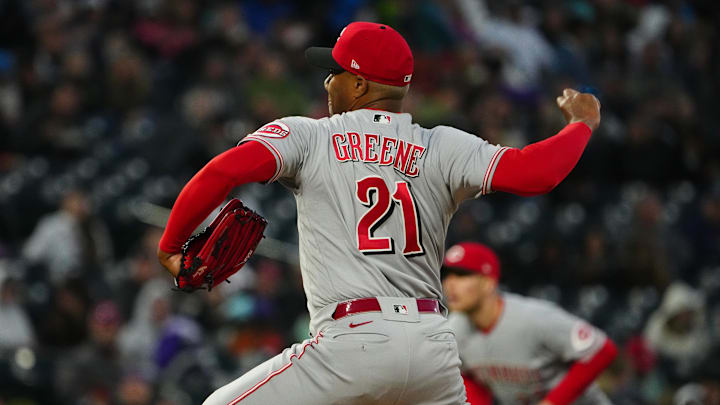For the second straight game, Hunter Greene failed to top 100 mph. But the Cincinnati Reds rookie did see 99.1 mph on the radar gun, so that's a step in a right direction.
After getting two extra days of rest, Greene saw his fastball average 96.7 mph. That's certainly an improvement from the April 22nd start where Greene's four-seam fastball averaged just 95.8 mph. That was after hitting 100-plus mph on the radar gun 39 times in Los Angeles.
I maintain that Greene's inability to get his fastball up to 100 mph or more greatly affects his ability to get opposing batters out. That out-of-this-world velocity coupled with the ability to toss a 90 mph changeup or a slider at 87 mph with tremendous bite is what made Greene the top pitching prospect that he is.
Reds RHP Hunter Greene issued 4 walks to Rockies hitters.
Hunter Greene admitted after the game that he wasn't feeling 100% healthy. But under those circumstances, Greene said he's, "got to bear down, go out there and just compete." That might suggest that Greene isn't injured as much as he might be fatigued. Only he and the Reds training staff know for certain.
But one more thing that's certain is that Greene must find the strike zone. Last night's game saw the right-hander issue four free passes over 4.1 innings of work.
This is now back-to-back games where Greene was walked four opposing batters. The rookie didn't issues a single walk in his performance agains the Los Angeles Dodgers out in California and walked just two batters during his first major league start in Atlanta.
Greene's 10 walks rank third-most among Cincinnati starters behind Vladimir Gutierrez (15) and Tyler Mahle (11). Mahle, however, has an extra start and four more innings under his belt this season.
Greene also served up two home runs last night, but that's to be expected. With as hard as Greene throws, if a batter makes good contact, there's a fine chance that the ball might leave the yard; especially in the thin air of Denver, Colorado. The average exit velocity on Greene's fastball was 104.3 mph, so when the Rockies hitters were able to square up on it, that ball was hit hard.
Former Colorado Rockies pitcher Phillip Diehl had a less than stellar performance as well. After his Cincinnati Reds debut yielded two scoreless innings earlier this week, Diehl gave up four runs on five hits while issuing two walks. Rockies hitters had an average exit velocity of 106.6 mph on Diehl's heater.
It's difficult to remember sometimes that Hunter Greene is just 22 years old, so there are bound to be some growing pains. One thing you cannot do in the big leagues, however, is put runners on base without making them swing the bat. Greene is scheduled to get the ball again next Thursday in Milwaukee.
